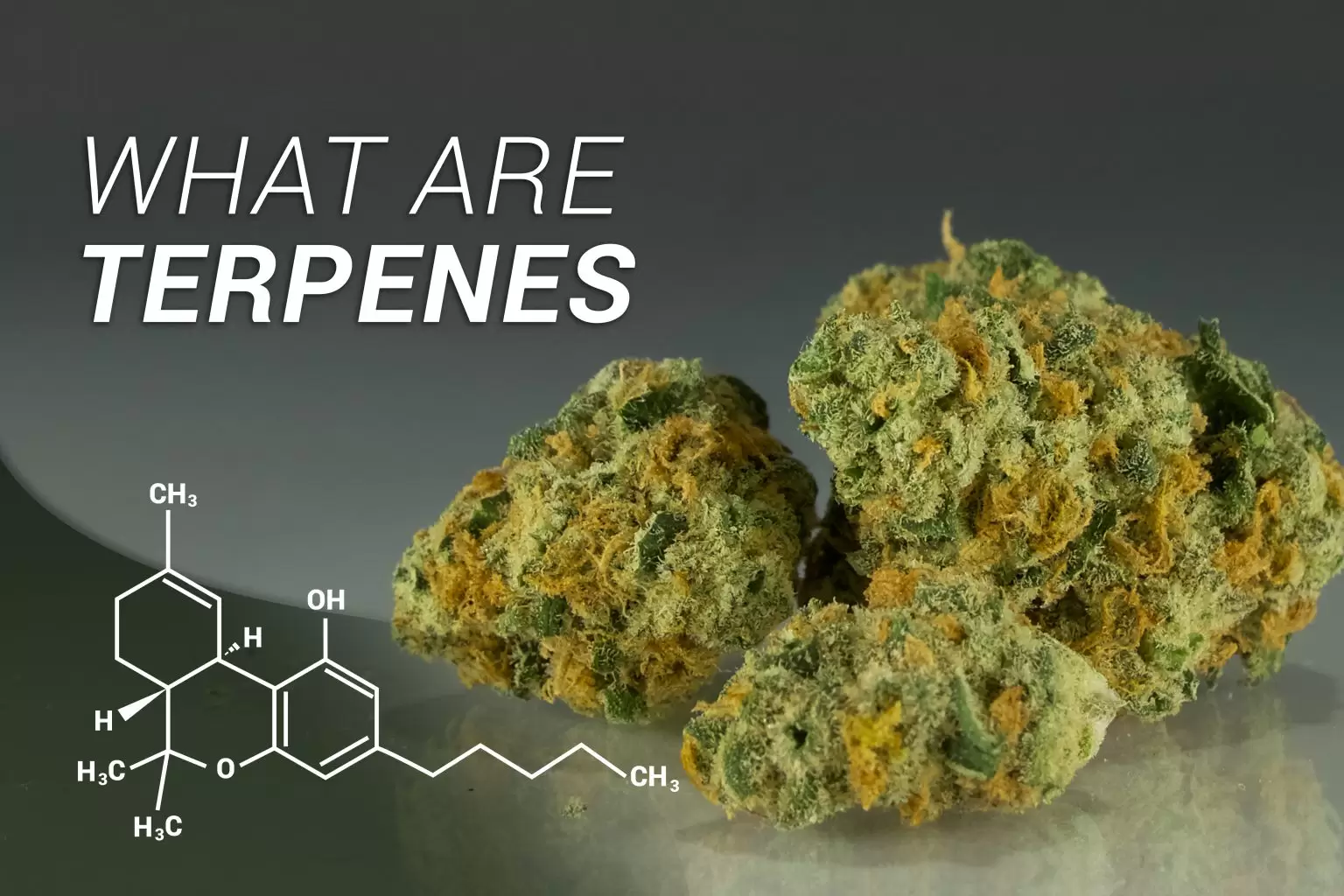
Hidden Treasures – Cannabis Terpenes
Did you know there are hidden treasures – Cannabis Terpenes. If you have ever walked past a hedge full of Jasmine plants, you have inhaled terpenes. Had a glass of orange juice? You have ingested them. Used Vicks vapor rub to clear congestion? Yep – those are terpenes too. We encounter terpenes all day every day because they exist in all plant life.
Scientists from Ancient healers to modern day pharmacists have leveraged the power of terpenes to benefit human and animal kind alike. Cannabis plants are particularly rich in terpenes. These extraordinary chemicals give cannabis (and all plants) there unique smells and tastes.
Most importantly, they also give plants their medicinal effects. Cannabis Terpenes are hidden treasures because while they make it smell great and taste unique – they also help it feel fantastic!

WHAT EXACTLY ARE TERPENES?
Terpenes are phytochemical (plant based chemical) compounds in plants that give each one flavors and aromas. They are also a part of the effects people feel from various plants. Most people are familiar with terpenes through aromatherapy (whether intentional or not). Lavender, for example, which is known to have calming effects and help with sleep, contains a large percentage of Linalool. Linalool is a “monoterpene” that contributes to Lavender’s sedating properties.
Similarly, cannabis contains a wide variety of terpenes that contribute to the effects of the plant. In fact, any one plant may contain about one-hundred different terpenes. While terpenes do not contribute to the “high” from high THC cannabis known as “marijuana,” they do influence how calming or, conversely, uplifting each strain of cannabis may be.
Terpenes give each cannabis strain its unique flavor and smell. These aromatic oils cause a strain to taste fruity or spicy and may give it a gassy or citrusy smell. For example, strains like “Lemon Haze” get their name from the lemony smell and taste of limonene. Limonene, prevalent in lemon haze, is one of the primary terpenes in lemons! Mmmm, so uplifting and fresh!
Cannabis plants make terpenes in the glands where they also produce THC and CBD. But terpenes do not always get much attention. We freely admit that cannabinoids are the “heavy lifters” of cannabis effects. However, it has recently been acknowledged that terpenes also play a major role in the plants’ effects on the human body and brain.
WHY PLANTS MAKE TERPENES
Obviously, plants can’t walk and talk, so they need other ways to interact with the world around them. They do this with chemicals, many of which are terpenes. Some terpenes help the plant defend itself from insects, others from microbial or fungal attack. Others may give the plant a delicious aroma that attracts helpful insects that provide pollination.
There are approximately 100 unique terpenes in cannabis. Each strain has a specific combination of terpenes.
While the same strain grown at different times usually has a similar chemical profile, the various type and quantity of terpenes in cannabis depends on many things. This means the same strain does not always make the exact same blend of chemical compounds. Climate and other environmental factors, soil health, fertilizers and the age of the plant can all impact the mix and strength of terpenes in each plant.

Terpenes are responsible for cannabis’ blend of flavor and aroma. But, even more importantly, terpenes work together with the cannabinoids like CBD. Two unique strains may have the exact same levels of CBD and THC, but very different effects. Cannabis scientists now know that terpenes work together with the cannabinoids to give each strain its particular therapeutic effects.
HOW CANNABINOIDS AND TERPENES DIFFER

Cannabis produces hundreds of different phytochemicals that fall into several categories. Terpenes create the unique aroma of pine forests, citrus peels, and, of course, fresh cannabis.
Overall, cannabis plants make upwards of 200 different terpenes. Each type of plant has varied quantities of terpenes. This means the fragrant molecules make for diverse flavors and aromas of the different strains.
The chemicals cannabis is the best known for are cannabinoids. Some of them can be found elsewhere in nature, but THC and CBD are exclusive to hemp and marijuana. These therapeutic molecules create much of the medicinal effects of the plants. This includes the psychoactive “high” of THC to the calming and focused effects of CBD.
Interestingly, the difference between hemp and marijuana is only a legal classification. It is based on the concentration of the single cannabinoid delta-9 THC. Plants with less than 0.3% delta-9 THC are considered “hemp,” while plants with higher amounts are considered “marijuana.” They are the exact same plants from a genetic perspective and can be bred together. In fact, no one can tell the difference between them without lab tests verifying cannabinoid content.
SYNERGY - CANNABINOIDS & TERPENES TOGETHER PROVIDE THE BEST EFFECTS
Cannabinoids and terpenes act independently of each other, but they also create harmonious benefits through the Entourage Effect. THC and other cannabinoids bind to cannabinoid receptors (CB1 and CB2) all over the body. This interaction creates the sensations people feel when using cannabis. In contrast, most terpenes interact with different receptors.
Interestingly, there are a few molecules, such as caryophyllene that are considered terpenes and cannabinoids. It has both peppery and earthy aromas. But, beyond smell, this chemical is special because it acts just like cannabinoids. That is, it binds directly to the CB2 receptors in the endocannabinoid system.
Read about the intricate interactions between cannabis compoounds. The “Entourage Effect” is he reason full spectrum cannabis products are often more effective than other options
HOW TERPENES FUNCTION
Terpenes work in a variety of ways. In addition to giving pleasant tastes and smells to our experience of cannabis, they also impact the effects of the plant on the human body (and animals as well).
Researchers and scientists have recently identified the power of the relationship between terpenes and cannabinoids. Molecules of both types work together to increase the benefits of cannabis use. This relationship has been called the “entourage effect.”
An example of this is the relationship between CBD and linalool (known mostly from lavender). Both are calming and anti-inflammatory. Alone, they can each provide help with anxious feelings or falling asleep. Together, these effects are enhanced.
This is one of the reason we chose linalool as one of the primary terpenes in our “Relax” blends. In contrast, limonene (think lemons) and pinene (pine trees) are stimulating and can enhance focus. THC tends to be sedating, but these energizing terpenes can influence even high THC cannabis to be more uplifting.
Terpenes can also produce effects on their own without cannabinoids. As an aromatherapist, I am an advocate of the use of essential oils for a variety of conditions. Essential oils are the best example of concentrated terpenes. For this reason, essential oils are very often used in topical cannabis applications.
CAN TERPENES BE INTOXICATING?
Terpenes do not create a psychoactive high in the same way THC does. However, they can work in subtle ways to enhance mood through interaction with serotonin and dopamine receptors in the brain. These chemicals can influence the high generated by cannabinoids in notable ways. As described above, calming terpenes can make a more calming cannabis experience. Alternatively, stimulating terpenes can make it more uplifting.
DO TERPENES FAIL DRUG TESTS?
Definitely not! These molecules are found in all kinds of plants. Each of us ingests many terpenes each day. Simple things like orange juice contain terpenes. We inhale them with every breath we take while walking through the woods or passing those aromatic Jasmine vines.
DIFFERENCES IN HIDDEN TREASURES - CANNABIS TERPENES
DIFFERENT PLANTS - DIFFERNT TERPENES (USUALLY)

SATIVA VS INDICA EFFECTS
Some people think cannabis is sedating. Others consider it more uplifting. These beliefs typically relate more to the terpenes in the plants rather than the concentration of Cannabinoids such as THC and CBD. There is a great deal more to cannabis than these two primary chemicals. Many people are familiar with other minor cannabinoids like CBG, CBN, CBC, etc. However, many of the effects of cannabis come from terpenes.
Most people familiar with cannabis know about Indica versus Sativa effects. These relate to the two common species of cannabis. These are Cannabis Indica and Cannabis Sativa. The common beliefs are that Indica (Into Couch) effects are more sedating. In contrast, Sativa effects uplift and energize. Hybrids (cross breeds of the two species) combine these effects. Traditional wisdom tells us that Indica strains are for evening use, hybrids for anytime use and Sativa for daytime use.
A NEW PARADIGM?
However, cannabis scientists have recently challenged these beliefs. They have delved more deeply into the science of terpenes. The effects of any strain can be linked to the specific cannabinoid and terpene profile of the plant. Indica and sativa species relate to the appearance and growth of the plants. But they don’t always reveal the specifics of its chemical makeup.
THC is the largest influencer of the psychoactive effects of a cannabis strain. However, different strains can produce different highs. Terpenes cause these differences. The entourage effect means the whole plant has enhanced effects over the individual components. This blend of individual effects determines if a high will be more physical and relaxing or cerebral and stimulating.
WHAT'S NEXT FOR TERPENES?
Recent enhancements to the science of cannabis has led some scientists to give up the idea of strains. Plants of the same type can have very different terpene levels. Therefore, some suggest a new set of “chemovars.[3]” This system classifies plants based on their unique phytochemical profiles and resulting effects.
People are using cannabis more and more as the legal landscape changes. A wide variety of specific conditions are now being treated with these terpene rich plants. It will be interesting to see how the science evolves as more research is done. We will add information on this topic to our blog soon. Watch for future articles on specific terpenes and their role in the effects of cannabis.
